Husqvarna has two street legal models for the U.S. market this year, both featuring a potent, large displacement single-cylinder engine. The 701 Supermoto and 701 Enduro are completely new, and on paper look like they could be a single-cylinder enthusiast’s wet dream.
Let’s start with the engine common to each model. The 690 cc thumper is compact and light (only 95 pounds), but puts out some very impressive power. Husky claims 67 hp at 7,500 rpm and 49 pound/feet of torque at 6,500 rpm. The dyno chart shared by Husky shows close to 40 pound/feet of torque as low as 3,000 rpm, with strong power made all the way through 8,000 rpm. A big spread. Two spark plugs ignite the fuel/air mixture in the combustion chamber, which breathes through large intake and exhaust valves (four in total).
The throttle is ride-by-wire and fuel injection is via a 46 mm Keihin throttle-body. Each bike has three, selectable ride modes, including Advanced, Soft and Standard. Even a “bad” map is available for that nasty, low quality fuel you might find from time-to-time (Mexico desert run, for instance?). The engine now features a counter-balancer to reduce the vibes inherent in a big single. The transmission is a six-speed, and features a slipper clutch.
The engine is housed in a chromoly steel trellis frame that Husky managed to build at just 18 pounds. The trick sub-frame is molded from high strength plastic and integrates a 3.4 gallon fuel tank. This sub-frame is strong, with Husky claiming a passenger, luggage and even a larger fuel tank can be supported.
The two bikes feature WP suspension, but with different designs and travel. Not surprisingly, the Supermoto gets shorter travel with 215 mm (8.5″) in front and 250 mm (9.8″) in back. The Enduro, on the other hand, has 275 mm (10.8″) of travel both front and rear. The WP forks on the two bikes are also of a different design, with the Supermoto getting separate function forks featuring compression damping in one leg and rebound damping in the other. Forks and shocks on each model are fully adjustable.
The Supermoto, of course, gets 17″ wheels and street rubber on tubeless (hooray!) rims. The Enduro gets DOT knobbies on a 21″ front and 18″ rear wheel, respectively. Each bike uses the same rear brake, a single-piston Brembo caliper squeezing a 240 mm disc. The Supermoto has a killer front brake, i.e., a huge 320 mm disc slowed by a Brembo radial-mount, four-piston caliper. The Enduro has a slightly smaller 300 mm front disc operated by a two-piston Brembo caliper. Advanced Bosch ABS braking is standard on both the Supermoto and the Enduro. An optional dongle allows the rider to adjust the ABS, such as turning it off completely or applying ABS only to the front brake (do you like to back it in?).
We spent Day 1 on the street riding the 701 Supermoto. Our test rider, Russ Somers, is an expert off-road racer. He is well over 6′ tall, but found the ergonomics of both bikes comfortable. The seat, however, is relatively hard and very slick. Easy to move around on, when aggressively riding off-road, for instance, but in general the seat could use a bit more grip. Despite this, seat comfort is not a big complaint, although there will undoubtedly be after-market, cushier units available. The Supermoto seat height is 35″, 1″ shorter than the Enduro.
With the engine map dialed to “Advanced”, we set out on a street ride that allowed us to sample a variety of corners together with some high-speed straights. The first thing you notice is a very crisp, but accurate, response to the throttle by the fuel injection system. With good power right off idle, the 701 Supermoto starts to pull hard in the mid-range and begins to flatten out somewhat at high rpm levels. A good spread of power.
The accurate fuel injection allows you to pick up the throttle mid-corner, and really drive hard as the bike hits the mid-range of the powerband. The power is beefy enough to easily loft the front wheel in 3rd gear without the clutch. The six-speed transmission offers plenty of gear choices on the street and a top speed well north of 100 mph (we saw 108 mph at one point).
That new engine counter-balancer seems to make a significant difference, with engine vibration a non-issue. You still know you are riding a big single, but even at steady throttle at higher speeds, the motor is smooth. Rubber-mounted handlebars don’t hurt. If you can get the seat comfort to work for you, this bike would definitely be workable as a part-time commuter.
The slipper clutch makes it virtually impossible to lock up the rear wheel when aggressively downshifting and keeps the chassis balanced entering corners. This is a good thing given the handling limits of the Supermoto … which are extremely high.
Although easy to ride with that smooth, linear power and comfortable ergos, the 701 Supermoto can come alive under a skilled pilot. At a claimed 330 pounds dry, this bike is an absolute blast to ride, and it can attack tight, twisty canyon roads in a way no sport bike can. The tighter the better! The tires stuck like glue, and never felt like they were about to break traction (unless you chose to purposely lock-up the rear wheel – we had the bike set up with ABS turned off in back). The brakes are excellent, particularly that stout Brembo front brake, which seems to have power to spare with plenty of feel and feedback.
Day 2 was spent off-road on the 701 Enduro. We covered some high speed stuff, such as fire roads, as well as more technical terrain (some strewn with rocks). The 701 Enduro proved to be a very serious off-road weapon for a street-legal dual sport. Not too surprising given the heritage of Husqvarna Motorcycles. The Enduro has a slightly longer wheel base and more relaxed steering geometry than the Supermoto, and for a dirt specialist like Russ it feels like a big bike off-road. Claimed dry weight is down a bit from the Supermoto at 320 pounds.
If the engine felt like more-than-enough on the street, there really was no off-road situation where the rider wants for more power for different gearing. First gear on the Enduro is extremely low, and once underway rarely used. Being a six-speed, however, there was still plenty of gearing to accomplish just about anything a rider wants. From lower speed rock crawling all the way to an indicated 100 mph, the big 690 cc mill always answers your right wrist with a resounding “Yes”.
The longer travel suspension on the Enduro is set up well. Although Russ is heavier than the average rider, the suspension remained reasonably plush and reactive despite sitting lower in the travel than it would for the target 165 pound pilot. Traction from the stock Continental TKC80 tires was good, particularly from the rear. The front tire washed out on occasion, but it was difficult to tell whether this was a result of the tire design or the fact Husky was running 23 psi to avoid pinch flats during a day that included more than 100 miles of mixed off-road and street terrain.
The 701 Enduro handled well, both through choppy, high-speed stuff and in the corners. Bigger and heavier than a motocross bike, for instance, cornering technique has to respect the size and weight of the 701. Given its role as a high-speed dual sport, we really can’t complain about the handling. “Balanced” might be a good description, and controlling power slides off-road with the throttle was a piece of cake.
On the street, the Enduro offered decent grip in corners (not as much as the Supermoto, of course) and tracked straight and steady at higher speeds. The front brake lacks the outright power of the Supermoto, but during our test it never failed to offer up sufficient braking power.
Husqvarna claims a 6,200 mile service interval, and we are not in a position to comment on reliability at this point. Nevertheless, given the fact that this bike is developed from the 690 cc KTM that has been around for several years (and is now much smoother thanks to the counter-balancer), we would expect both 701s to provide many miles of grin-inducing travel for owners.
Both of these bikes are impressive. You are not going to find a more powerful single-cylinder engine, particularly one as smooth and usable. The chassis on both bikes is rock solid, the ergos comfortable, and the suspension well damped. You can tell Husky did a good job testing, and setting up these new machines. If you love single-cylinder bikes, and can imagine a 690 cc without significant vibration problems, be prepared to fall in love. Your choice of the Supermoto or the Enduro depends on the type of riding you do, but we don’t think you would go wrong with either choice.
Both bikes are priced at $11,299 in the United States. Take a look at Husqvarna’s web site for more details and specifications.
See more of MD’s great photography:
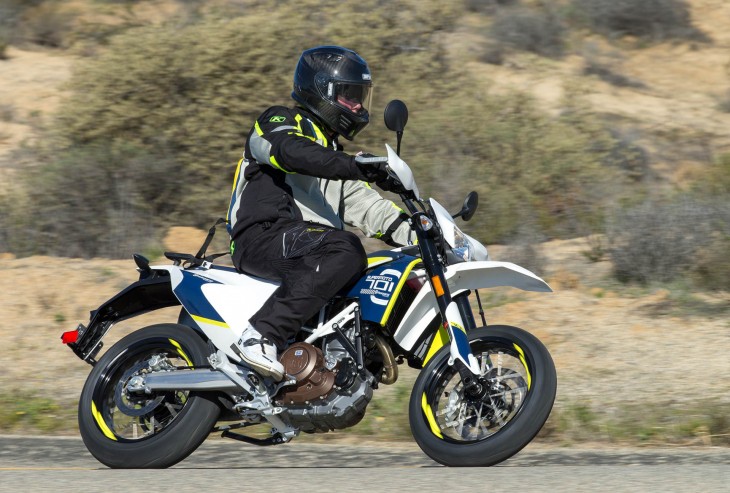
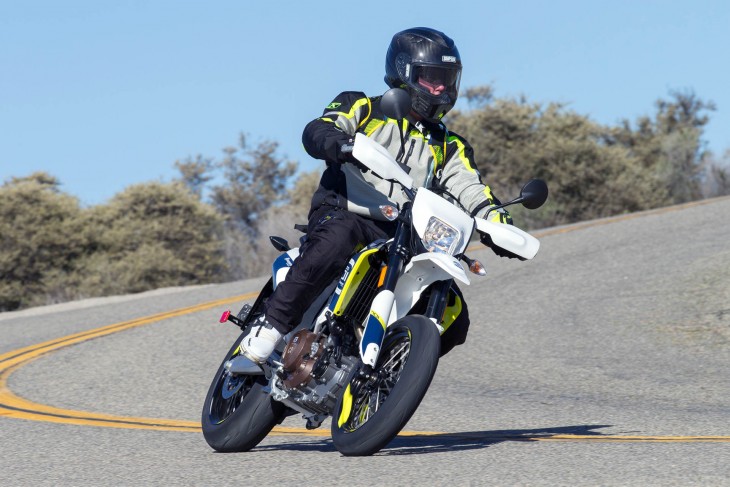
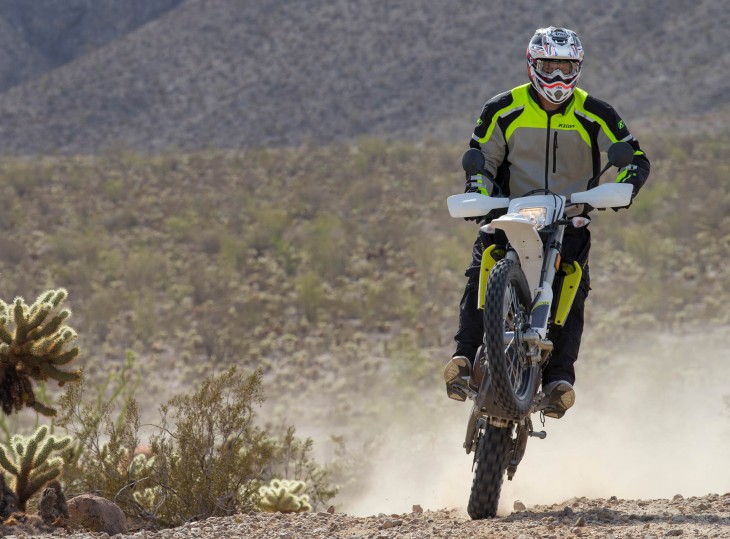
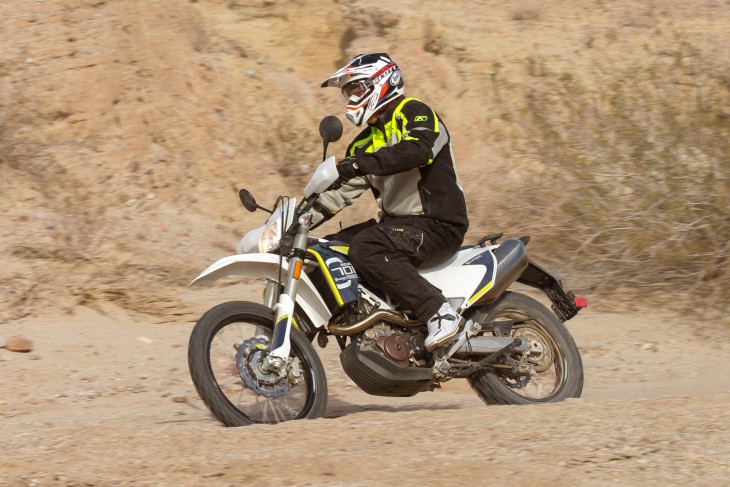
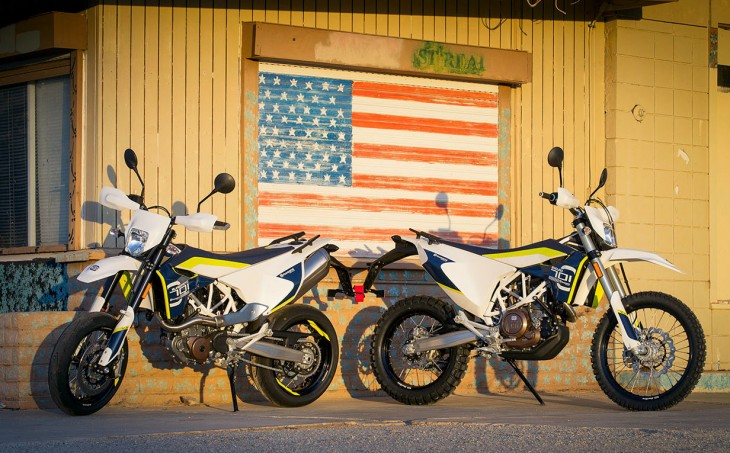






These two sound like very good bikes and they will be bought for function. But Yellow, Blue and White with weird wheel stripes?? The last Husky I owned (ok, it was a long time ago) had a chrome tank trimmed in red and it looked very classy. Say what you will, looks sell a lot of hardware.
I guess if their looks and color scheme don’t ignite a fire you’d have to look past that to function. I’ve owned several vehicles that many wouldn’t have cared for looks-wise but they served my needs so closely that I saw beauty in their function.
When I think Husqvarna I think: http://www.vintageworksbikes.com/sitebuilder/images/IMG_6351-880×666.jpg
for my generation THAT is a Husky
The first Huskies I remember were blue, white and yellow, so the color scheme of these resonates with me. My own Husky is red and white, though.
Man you must be a pup Jeremy lol. My kids grew up with red and chrome Huskys. Can you imagine a mfg trying to please cross generational customers in design with anything?
Luckily for you my generation of preferences are headed for the old folks home and wont be much of a factor in another decade.
Haha, it’s all relative I suppose. I’ll be 40 this year and hardly consider myself a pup. It was sometime in the mid to late ’80s when I saw my first Husqvarna tearing up the local “hay field” track (man, they don’t have many of those anymore). It looked glorious in its blue, white and yellow livery being piloted by the local fast guy. I was around 10 or 11 years old or so, and I just thought it was the coolest because the name was so fun to say and because it was called a “Husky” for short!
If you google “Husky Moab” you’ll see a concept bike they had that came pretty close but looked rather blocky
I remember seeing that. I don’t know what the old color scheme does for today’s crop of rider but it screams Husky to me. To me, the styling and graphics of these two blend into the background. They look like a brand taken over by another, like a loss of identity. But hey, that’s me.
Check this Husky out. 490 cc twin cylinder 2-stroke – winner of the 1969 Baja 1000
http://prerideguide.com/?p=501
+1
I agree … Husky should offer these 2 bikes in traditional, grown-up colors ie. Red or Black Tank, Silver frame. Race team based paint jobs may sell dirt bikes to kids, but that is not the demographic these $11k bikes are going for.
Most Motocross, Supercross, and Arenacross riders look like someone threw up Skittles on them. Gone are the days when we had classy paint and color-coordinated gear.
Wish KTM would have left Husaberg alone. Competition is good for development and Husaberg’s last bike with the 70 degree engine was evidence of that. Love my FE450, handles like a 250 and runs great… once you change out the fuel pump that is!
Husky 701 SM – $11,299 and KTM 690Duke – $8,999 (2016) with more hp and smoother – “Hello, McFly”! I don’t need my supermoto that pure – same wheels, tires and brakes after all.
Valid point Don! That $11K+ price tag seems high to me. The KTM 690Duke is a fantastic bargain by comparison.
The Duke is a VERY different bike. One is a supermoto, the other a standard. About the only thing they have in common is two wheels and an engine.
What can be done on the street with a super-moto that can’t be done just as well with the Duke?
What can this Husky super-moto do that a KTM or other, less expensive super-moto can’t?
I always thought of the Duke as a quasi-supermoto.
(rim-shot) I see what you did there Todd.
Bravo!
This is one of those rare times that I wished to be taller and have more than a 29″ inseam with regards to motorcycles. That Moto model looks like a fun beast to ride.
If you set up the suspension properly, it will sag about 1/3 of its original height. Since the average suspension travel is about 9 inches, you would set up the 1/3 rule and it would bring the seat height down 3 inchee, from 35 inches to 32 inches.
All you have to do is slide your rear off of the seat and one foot it.
As someone who lived in S. America for years and watched hundreds of vertically challenged people in the 5’5″-5″7″ range ride MX & Enduro bikes through the Andes Mountains I know it can be done easily. IN fact I once had a Japanese lady who was about 5’3″ TOPS do a tour . . she would slide to the side or find a curb/rock or when no other option she’d stand up and dismount as she came to a stop and when the light went green take off, stand up and swing her leg over the saddle..
Bottom line is you either need to just man up, Japanese Lady Up or just quit making excuses.
kids have been riding dirt bikes way taller than them for years.
not too many people can flat foot both feet anyway. id say try it.
You and I are in the same boat inseam-wise. I’d go give one a try if you can find a dealer and you think that SuMo is something you really want. These things are light and narrow, so it isn’t as difficult to get a foot down as you might think just looking at the seat height on paper. I have a dual-sport and a 500+ lb adventure bike that both have 35-inch seat heights. While they aren’t the most fun things to back up or get stuck in stop-and-go traffic with, I don’t give the seat height a second thought otherwise.
HA I test rode a Super Tenere’ and upon returning from my test ride could not reach to get the side stand down so I could get off. Son had to walk over and kick it down for me. Ever ride just over a curb and have to stop? Or end up on the high place in the road with a low spot on each side? Step in a bit of fine gravel as you are backing up?
I wish they made bikes with 45″ seat heights for you guys that think you only need 1 foot on the ground.
IMO you at least need toes touching on each side. If one of your feet is on the ground and the other is dangling next to the offside footpeg, the bike is too tall for you.
I’m not saying all bikes should come with a 30″ seat height, I’m saying not all riders can ride a bike with a tall seat height comfortably. Some bikes and rider combos just don’t work.
I’ve got a 36″ inseam, so I’ve never been on a bike too tall, but I’ve still dumped many over for the reasons you describe. I once had my pants cuff catch on the peg as I came to a stop, so now I ride with my pants tucked into my boots.
Isn’t this engine a 1st generation Duke motor? I thought I read that KTM had upgraded the new engine.
36″ wow. I’d be breathing different air if I had those legs. Man would that open up possibilities to the bikes I could own. Mine is a true 26″. I’ve been on a LOT of bikes that are too tall. Still I don’t expect manufacturers to build bikes to fit me, but at least throw me a bone once in awhile lol. My problem..I’ve got a cruiser body, but a sport tourer head.
I’ve been riding on 34″-35″ seats for a while, and I’ve never dumped a bike on the street because of short inseam issues. Off-road is a different story, though I am sure even then one could argue that is a lack of skill issue and not an inseam issue.
Like I said, I only ever have one foot on the ground (the ball of one foot actually) on my bikes, so I am not one of those guys that can flat foot an Adventure R (in fact, both my feet will dangle in the air when the bike is upright). I’m just used to it.
That said, I test rode a BMW RnineT the other weekend, and man did it feel nice to flat foot a bike! Can’t remember the last time I had that sensation.
Where the hell do the manufacturers keep getting 165# target rider weights??
165 lbs. is the average European adult body weight: (180 lbs. average for men + 150 lbs. average for women)/2.
Thank goodness the Euro brands have picked up the torch and have developed some modern dualsport bikes. If it was left up to the japanese, we would have bold new graphics on their ancient 300 pound 30 hp air cooled scrap heaps to look forward to for the next 100 years
Exactly why I have a European dual sport. I’d much rather have a modern Japanese one, but the Japanese OEMs have shown zero interest in producing a modern big-bore dual sport.
Wouldn’t the Africa Twin be considered a Dual Sport? I think of it that way.
It might be considered a dual sport by someone with much more skill and courage than I can muster. I consider the Africa Twin an adventure bike. I go over things on a dual sport that I would likely need a crane to clear on an Africa Twin. Mine weighs right in around 400lbs all farkled out, and that is about the limit for me for technical stuff.
My days of riding a dual-sport are long gone, not that I couldn’t ride one but rather that other bikes suit my type of riding better. That and any truly decent off-roading is miles and miles away. Envisioning myself on either a dual-sport or Adv bike their use would be pretty much the same. That’s exploring off-road where street bikes would be out of their element. That’s why I mentioned the Africa Twin. I suppose to blur the lines between the two types, a dual-sport could be considered to have an extra shot of dirt in its DNA while an Adv bike (generally) would be the better choice for more road work.
That is typically how I regard the difference. In truth even my Husqvarna would be considered more adventure bike than dual sport my most people. I can follow the little 250cc dual sports on the Husky wherever they go, though it certainly takes a lot more work to get it done when things get technical. It can also cruise along comfortably at 80mph all day long with power to spare which is something the little 250s definitely can’t do, so it strikes the right balance for me to call it a true dual sport.
I like the DRZ400 quite a bit. I used to have a KLX300, highly modified and plated for the street. That thing was awesome. I once borrowed a KLR650 for a week. It was well suited to the road but a little too ponderous off road. My XR650L is pretty decent on and off road, if a little heavy off -especially compared to the KLX300 which was a gem. I also own a ”72 RT2 (360) and it a makes a decent dual purpose bike for shorter adventures, that thing has tremendous torque. I’ve been eyeing the Yamaha XT225/250 for some time, owners are quite happy with those as a do-it-all bike. I wouldn’t say that Japan doesn’t have much to offer and 30ish horsepower is fine for beating traffic and breaking speed limits.
The 2016 KTM 690 Duke received a new engine this year – I believe with two counterbalancers. Has the 701 inherited this same engine? I was under the impression that the 701 still had an older design. Can anymore verify this for me?
NO !!
The Husky does not have the new KTM engine unfortunately. I will wait until the 701 gets the NEW engine because it is a significant upgrade.
That’s disappointing. I would have been very interested if it had the updated ‘Duke’ engine – strange that it has a ‘new’ counter balancer but not the dual. Glad to hear that the Enduro doesn’t have the too tall 1st gear of its KTM cousin so that’s progress.
Thanks Tony. I see that as a significant upgrade too, so I will hold off as well.
Thanks GDC … that was my question as well.
Well written, and what a pair of bikes! Not much to dislike, except maybe small dealer network. The dealer I spoke to in Idaho was extremely nice, with good product knowledge.
As absolutely enticing as this 701 Enduro is, knowing my riding, I would be jonesing for more technical terrain and a lighter overall package and end up on a 501 Enduro. But that’s me. Maybe I need both?
You’d buy one of these (the SM) over a KTM because KTM doesn’t sell a supermoto in the US. And it sounds like the engine is improved and the suspension is improved over what’s available on the 690 Enduro (if you wanted to turn the Enduro into a supermoto). I’m really tempted by this bike.
I commend Husky for staying busy. I look forward to Vitpilen 401/701. Maybe a version with a little friendlier handlebar (?)
I guess the questions is…why would you buy one of these over a KTM? Technically, no pure “supermoto” from KTM I guess? Though the Duke is very, very good. And the Enduro 690R is also very good.
Husky has roots going back much longer in the US than KTM. And less of a Roaring Red Buller image, which may help them sell to some who find the whole bright orange, wheelie or die, attitude a bit much.
Man, these are two nice bikes! I’ve ridden a 690 Enduro quite extensively, and it is a very choice piece of kit. But so are SUMOs…. Good thing they are both narrow enough to easily fit side by side in even a Taco bed. May even be able to squeeze a Duke or Vitpilen in there with them….. The LC4 is such an absolutely awesome engine.
The LC4 is such an absolutely awesome engine.
I read an interview not long ago, and a big reason Pierer picked up Husky was because brand’s long history would allow KTM to develop “heritage” products which is something he said that doesn’t fit in with the KTM brand.
I called this one wrong when he acquired Husky: I thought they would eventually take the brand off line to eliminate a competitor to KTM. Looks like they have some big plans for Husqvarna in the future.
I believe that KTM is positioning Husqvarna to be a “premium” brand compared to KTM. Similar to that of Acura to Honda and Lexus to Toyota. They are priced slightly higher and for that you get a few Husky exclusive bits, such as the plastic subframe.
I find it a bit humerous to hear references to the “new” Husky’s roots and heritage. The only things that Pierer acquired were the brand and logo. All current Huskys DNA comes from KTM and their Husaberg division.
By “heritage” products, I think he is probably referring to something retro or nostalgic. Which probably means something that looks very Ikea, like the Vitpilen. The brand has a heritage regardless of where the current bikes’ DNA come from.
I think they are trying to create a different experience for potential customers around the Husky brand, but I don’t see them doing that in a Lexus/Toyota kind of way. KTM considers itself a premium brand (so do I), and I can’t see them minimalizing that by positioning Husqvarna on a higher wrung.
I still see the new Huskies as nothing more than rebadged KTMs at this point. But if they really start introducing new models with a unique, ccandinavianish flavor again like the Vitpilen concepts pull off, then I think they can become Husqvarnas again – even with full KTM underpinnings.
“new” Husky’s roots and heritage.”
Sort of like Instant Tradition.
A lot of that going around lately. If you don’t have any heritage just buy it.
Actually the first two Husqvarna’s came to the US in 1966. The first 10 Penton motorcycles, built by KTM arrived stateside in 1968.
Me like! Thanks for the review Dirck.